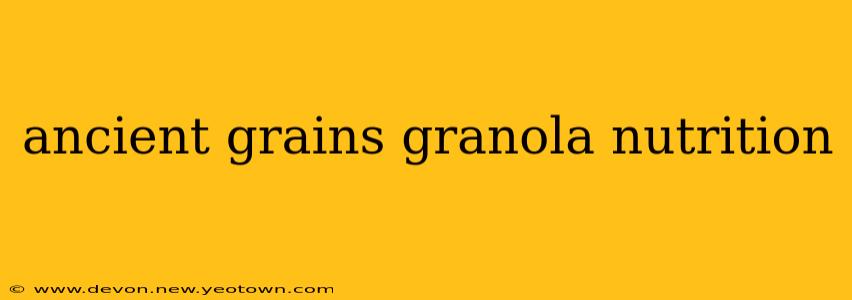Granola, that crunchy, sweet breakfast staple, has gotten a delicious upgrade. Forget the processed oats and refined sugars – we're diving into the world of ancient grains granola, a nutritional powerhouse packed with flavor and benefits that go far beyond your average breakfast bowl. This isn't just a trend; it's a delicious return to wholesome, nutrient-rich ingredients that our ancestors knew and loved.
Imagine this: the sun warms your face as you savor a bowl of granola, its satisfying crunch awakening your senses. But this isn't just any granola; this bowl is bursting with the wholesome goodness of ancient grains, each bite delivering a unique blend of nutty flavors, subtle sweetness, and a significant nutritional boost. Let's explore what makes ancient grains granola so special.
What are Ancient Grains?
Before we delve into the nutritional profile, let's clarify what makes a grain "ancient." These aren't grains plucked from a time capsule! Ancient grains are simply those that have remained largely unchanged for centuries, having avoided the extensive hybridization and genetic modification common in modern agriculture. This often translates to a richer nutritional profile compared to their modern counterparts. Examples include:
- Kamut (Khorasan Wheat): Known for its nutty flavor and high protein content.
- Spelt: A close relative of wheat, offering a slightly sweeter taste and excellent fiber.
- Farro: A hearty grain with a chewy texture and a surprisingly robust nutritional punch.
- Freekeh: A roasted green wheat grain, packed with antioxidants and fiber.
- Quinoa: Technically a seed, but often grouped with ancient grains, known for its complete protein profile.
These grains bring a unique depth of flavor and texture to granola, creating a truly satisfying and wholesome breakfast experience.
What are the Nutritional Benefits of Ancient Grains Granola?
The beauty of ancient grains granola lies in its diverse nutritional profile. Unlike many processed breakfast options, this granola boasts a wealth of vitamins, minerals, and fiber, contributing to overall health and well-being.
Is Ancient Grains Granola High in Fiber?
Yes! Ancient grains are exceptionally rich in fiber. Fiber is crucial for digestive health, promoting regularity and preventing constipation. It also helps regulate blood sugar levels and can contribute to feelings of fullness, aiding in weight management.
Is Ancient Grains Granola Gluten-Free?
Not necessarily. While some ancient grains like quinoa are naturally gluten-free, others, such as kamut and spelt, contain gluten. Always check the ingredients list to ensure it aligns with your dietary needs. Many brands now offer gluten-free ancient grains granola options, making it accessible to a wider audience.
What are the Vitamins and Minerals in Ancient Grains Granola?
Ancient grains are a good source of various vitamins and minerals. The specific nutrient profile varies depending on the grains used, but generally, you can expect a good dose of:
- Magnesium: Essential for muscle function, blood sugar control, and blood pressure regulation.
- Iron: Crucial for oxygen transport and red blood cell production.
- Zinc: Supports immune function and wound healing.
- B Vitamins: Important for energy production and nerve function.
How Many Calories are in Ancient Grains Granola?
Calorie count varies greatly depending on the recipe and added ingredients (like nuts, seeds, and sweeteners). However, generally, ancient grains granola provides a satisfying amount of energy without the refined sugar crash often associated with sugary cereals. Always check the nutritional label for specific calorie information.
How to Choose the Right Ancient Grains Granola
Selecting the perfect ancient grains granola requires a little attention to detail. Look for brands that:
- Use whole grains: Avoid those with added refined grains.
- Minimize added sugar: Opt for options with lower sugar content.
- List specific ancient grains: Knowing the types of ancient grains used allows you to tailor your choice to your preferences and dietary needs.
- Have a short ingredient list: The fewer the ingredients, the better.
With a little mindful shopping, you can find a truly wholesome and nutritious ancient grains granola that perfectly complements your healthy lifestyle. So next time you reach for your breakfast bowl, consider the power of ancient grains and embark on a delicious journey to a healthier you.

